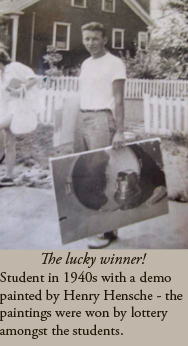Painting Demonstrations
At the Shinnecock outdoor painting school William Merritt Chase was known as an excellent demonstrator of painting, dazzling his students with his swift and assured brushstrokes, dramatically conjuring a chiaroscuro of fish against backdrops of copper and brass.

Hawthorne continued in the tradition of Chase, the man for whom he had served as teaching assistant in the late 1890s. For Hawthorne the weekly “demos” were almost always outdoors, usually a painting of a model on one of the piers in Provincetown where he established his famous Cape Cod School of Art.
The tradition endured well into the 1980s with Henry Hensche, who was in turn, Charles Hawthorne’s teaching assistant in the last three years of Hawthorne’s life. Hensche demoed on the beach of Provincetown, often at the bottom of Pearl Street. In the 1940s he began painting his demos in his backyard at 12 Conwell Street. The students sat on the sloping lawn - Hensche painting in front of Ada’s garden, usually completing the painting in just two hours. Taking just one break - Ada would bring him out a snack - and the students would gather around the painting and palette, sure that there must be some magic colors that he had on his palette that they didn’t have, or that the secret lay in the famed “Hawthorne medium” with which he painted.
In the early days he continued in the tradition of Hawthorne, usually painting the dramatic silhouette of a model against the blaze of light on the beach or in his yard. From the 40s until the late 1980s he also painted still life demonstrations as well as landscapes. When the tradition began, numbers were drawn to see which lucky student would take home the prize demo. In later years the demos were sold, always at a modest price, with Hensche often asking, “is that too much?” (In the late 1980s his 20”x24”demonstration paintings were sold for $250.00) |

